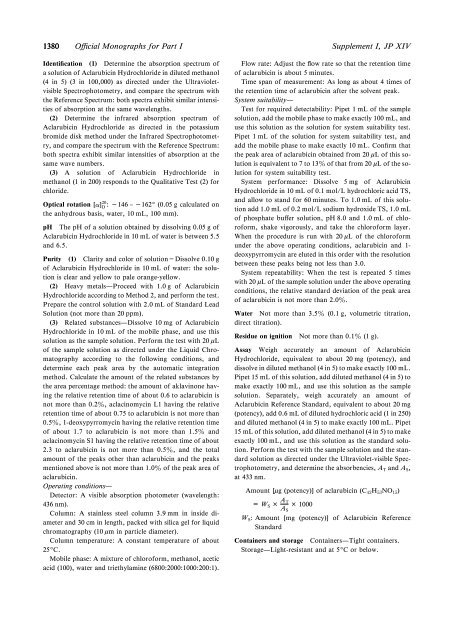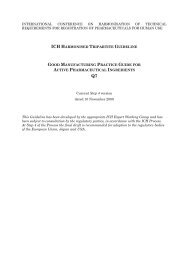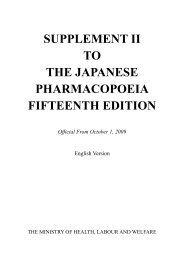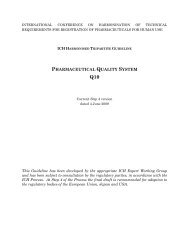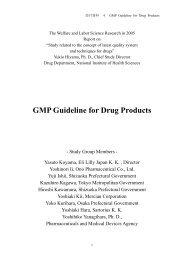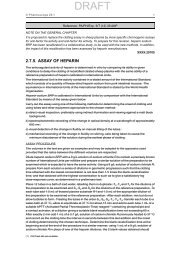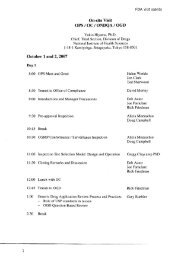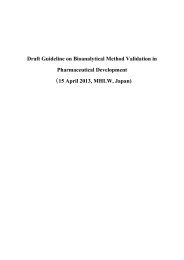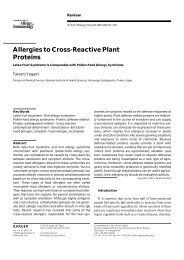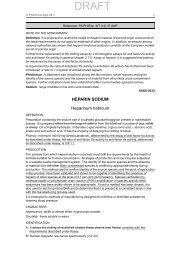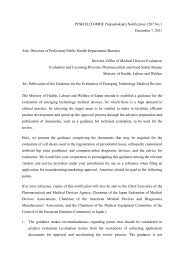Supplement I to the Japanese Pharmacopoeia Fourteenth Edition
Supplement I to the Japanese Pharmacopoeia Fourteenth Edition
Supplement I to the Japanese Pharmacopoeia Fourteenth Edition
Create successful ePaper yourself
Turn your PDF publications into a flip-book with our unique Google optimized e-Paper software.
1380 O‹cial Monographs for Part I<br />
<strong>Supplement</strong> I, JP XIV<br />
Identiˆcation (1) Determine <strong>the</strong> absorption spectrum of<br />
a solution of Aclarubicin Hydrochloride in diluted methanol<br />
(4 in 5) (3 in 100,000) as directed under <strong>the</strong> Ultravioletvisible<br />
Spectropho<strong>to</strong>metry, and compare <strong>the</strong> spectrum with<br />
<strong>the</strong> Reference Spectrum: both spectra exhibit similar intensities<br />
of absorption at <strong>the</strong> same wavelengths.<br />
(2) Determine <strong>the</strong> infrared absorption spectrum of<br />
Aclarubicin Hydrochloride as directed in <strong>the</strong> potassium<br />
bromide disk method under <strong>the</strong> Infrared Spectropho<strong>to</strong>metry,<br />
and compare <strong>the</strong> spectrum with <strong>the</strong> Reference Spectrum:<br />
both spectra exhibit similar intensities of absorption at <strong>the</strong><br />
same wave numbers.<br />
(3) A solution of Aclarubicin Hydrochloride in<br />
methanol (1 in 200) responds <strong>to</strong> <strong>the</strong> Qualitative Test (2) for<br />
chloride.<br />
Optical rotation [a] 20<br />
D : -146 – -1629(0.05 g calculated on<br />
<strong>the</strong> anhydrous basis, water, 10 mL, 100 mm).<br />
pH The pH of a solution obtained by dissolving 0.05 g of<br />
Aclarubicin Hydrochloride in 10 mL of water is between 5.5<br />
and 6.5.<br />
Purity (1) Clarity and color of solution-Dissolve 0.10 g<br />
of Aclarubicin Hydrochloride in 10 mL of water: <strong>the</strong> solution<br />
is clear and yellow <strong>to</strong> pale orange-yellow.<br />
(2) Heavy metals—Proceed with 1.0 g of Aclarubicin<br />
Hydrochloride according <strong>to</strong> Method 2, and perform <strong>the</strong> test.<br />
Prepare <strong>the</strong> control solution with 2.0 mL of Standard Lead<br />
Solution (not more than 20 ppm).<br />
(3) Related substances—Dissolve 10 mg of Aclarubicin<br />
Hydrochloride in 10 mL of <strong>the</strong> mobile phase, and use this<br />
solution as <strong>the</strong> sample solution. Perform <strong>the</strong> test with 20 mL<br />
of <strong>the</strong> sample solution as directed under <strong>the</strong> Liquid Chroma<strong>to</strong>graphy<br />
according <strong>to</strong> <strong>the</strong> following conditions, and<br />
determine each peak area by <strong>the</strong> au<strong>to</strong>matic integration<br />
method. Calculate <strong>the</strong> amount of <strong>the</strong> related substances by<br />
<strong>the</strong> area percentage method: <strong>the</strong> amount of aklavinone having<br />
<strong>the</strong> relative retention time of about 0.6 <strong>to</strong> aclarubicin is<br />
not more than 0.2z, aclacinomycin L1 having <strong>the</strong> relative<br />
retention time of about 0.75 <strong>to</strong> aclarubicin is not more than<br />
0.5z, 1-deoxypyrromycin having <strong>the</strong> relative retention time<br />
of about 1.7 <strong>to</strong> aclarubicin is not more than 1.5z and<br />
aclacinomycin S1 having <strong>the</strong> relative retention time of about<br />
2.3 <strong>to</strong> aclarubicin is not more than 0.5z, and <strong>the</strong> <strong>to</strong>tal<br />
amount of <strong>the</strong> peaks o<strong>the</strong>r than aclarubicin and <strong>the</strong> peaks<br />
mentioned above is not more than 1.0z of <strong>the</strong> peak area of<br />
aclarubicin.<br />
Operating conditions—<br />
Detec<strong>to</strong>r: A visible absorption pho<strong>to</strong>meter (wavelength:<br />
436 nm).<br />
Column: A stainless steel column 3.9 mm in inside diameter<br />
and 30 cm in length, packed with silica gel for liquid<br />
chroma<strong>to</strong>graphy (10 mm in particle diameter).<br />
Column temperature: A constant temperature of about<br />
259C.<br />
Mobile phase: A mixture of chloroform, methanol, acetic<br />
acid (100), water and triethylamine (6800:2000:1000:200:1).<br />
Flow rate: Adjust <strong>the</strong> ‰ow rate so that <strong>the</strong> retention time<br />
of aclarubicin is about 5 minutes.<br />
Time span of measurement: As long as about 4 times of<br />
<strong>the</strong> retention time of aclarubicin after <strong>the</strong> solvent peak.<br />
System suitability—<br />
Test for required detectability: Pipet 1 mL of <strong>the</strong> sample<br />
solution, add <strong>the</strong> mobile phase <strong>to</strong> make exactly 100 mL, and<br />
use this solution as <strong>the</strong> solution for system suitability test.<br />
Pipet 1 mL of <strong>the</strong> solution for system suitability test, and<br />
add <strong>the</strong> mobile phase <strong>to</strong> make exactly 10 mL. Conˆrm that<br />
<strong>the</strong> peak area of aclarubicin obtained from 20 mL of this solution<br />
is equivalent <strong>to</strong> 7 <strong>to</strong> 13z of that from 20 mL of<strong>the</strong>solution<br />
for system suitability test.<br />
System performance: Dissolve 5 mg of Aclarubicin<br />
Hydrochloride in 10 mL of 0.1 mol/L hydrochloric acid TS,<br />
and allow <strong>to</strong> stand for 60 minutes. To 1.0 mL of this solution<br />
add 1.0 mL of 0.2 mol/L sodium hydroxide TS, 1.0 mL<br />
of phosphate buŠer solution, pH 8.0 and 1.0 mL of chloroform,<br />
shake vigorously, and take <strong>the</strong> chloroform layer.<br />
When <strong>the</strong> procedure is run with 20 mL of <strong>the</strong> chloroform<br />
under <strong>the</strong> above operating conditions, aclarubicin and 1-<br />
deoxypyrromycin are eluted in this order with <strong>the</strong> resolution<br />
between <strong>the</strong>se peaks being not less than 3.0.<br />
System repeatability: When <strong>the</strong> test is repeated 5 times<br />
with 20 mL of <strong>the</strong> sample solution under <strong>the</strong> above operating<br />
conditions, <strong>the</strong> relative standard deviation of <strong>the</strong> peak area<br />
of aclarubicin is not more than 2.0z.<br />
Water Not more than 3.5z (0.1 g, volumetric titration,<br />
direct titration).<br />
Residue on ignition<br />
Not more than 0.1z (1 g).<br />
Assay Weigh accurately an amount of Aclarubicin<br />
Hydrochloride, equivalent <strong>to</strong> about 20 mg (potency), and<br />
dissolve in diluted methanol (4 in 5) <strong>to</strong> make exactly 100 mL.<br />
Pipet 15 mL of this solution, add diluted methanol (4 in 5) <strong>to</strong><br />
make exactly 100 mL, and use this solution as <strong>the</strong> sample<br />
solution. Separately, weigh accurately an amount of<br />
Aclarubicin Reference Standard, equivalent <strong>to</strong> about 20 mg<br />
(potency), add 0.6 mL of diluted hydrochloric acid (1 in 250)<br />
and diluted methanol (4 in 5) <strong>to</strong> make exactly 100 mL. Pipet<br />
15 mL of this solution, add diluted methanol (4 in 5) <strong>to</strong> make<br />
exactly 100 mL, and use this solution as <strong>the</strong> standard solution.<br />
Perform <strong>the</strong> test with <strong>the</strong> sample solution and <strong>the</strong> standard<br />
solution as directed under <strong>the</strong> Ultraviolet-visible Spectropho<strong>to</strong>metry,<br />
and determine <strong>the</strong> absorbencies, A T and A S ,<br />
at 433 nm.<br />
Amount [mg (potency)] of aclarubicin (C 42 H 53 NO 15 )<br />
= W S × A T<br />
A S<br />
× 1000<br />
W S : Amount [mg (potency)] of Aclarubicin Reference<br />
Standard<br />
Containers and s<strong>to</strong>rage Containers—Tight containers.<br />
S<strong>to</strong>rage—Light-resistant and at 59C orbelow.


